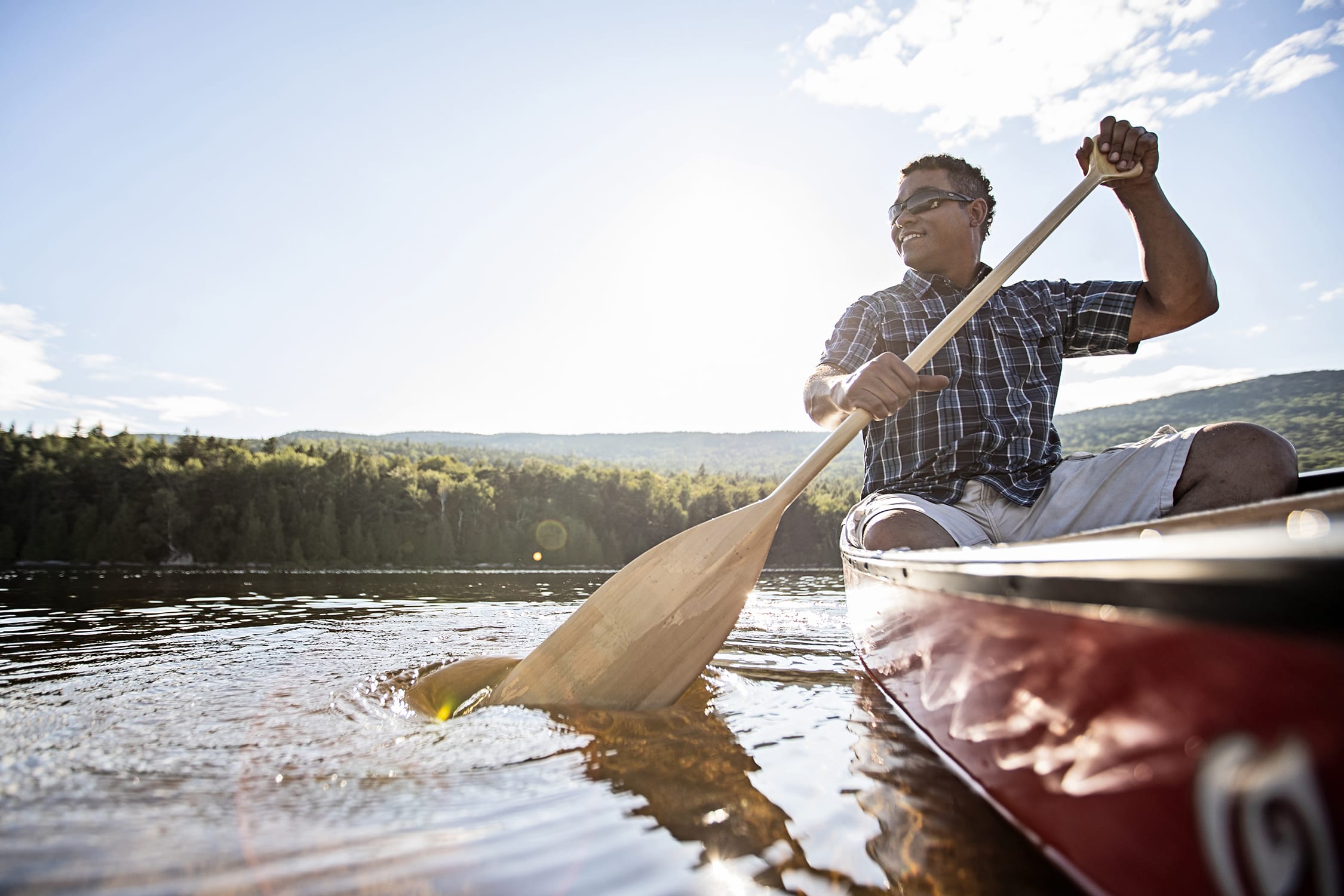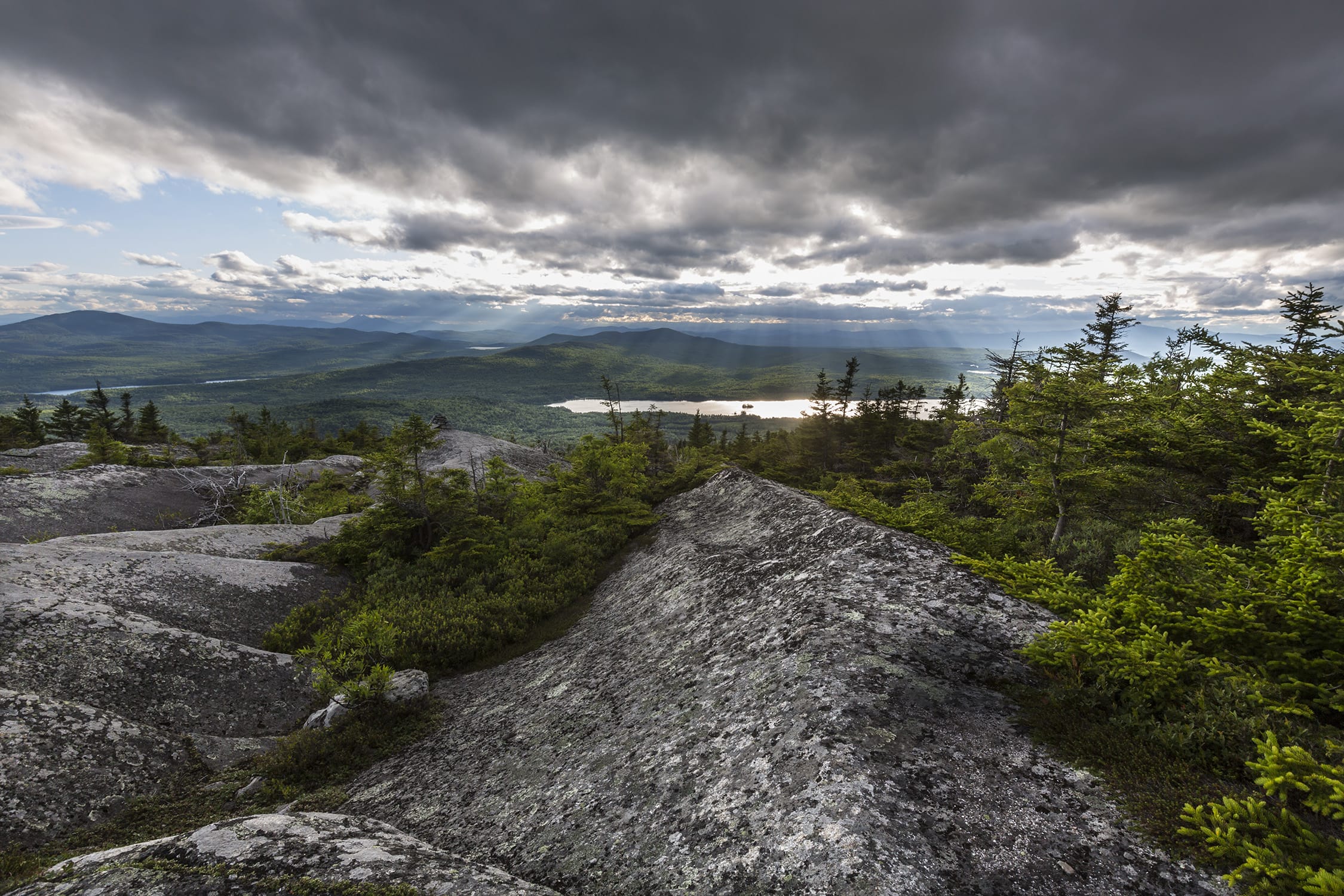The Appalachian Trail traverses woods, creeks, meadows and mountains across 2,190 miles, from northern Georgia to central Maine. It is beloved by hikers, whether those venturing onto a short leg for the day or tackling the entire length—a rite of passage for outdoor enthusiasts.
Yet as suburban development has crept into rural areas in recent decades, the trail’s wilderness experience sometimes seems under siege. Trust for Public Land has sought to counter that, protecting 319,000 acres across 150 projects along the full expanse of the Appalachian National Scenic Trail (known more casually as the AT). Much of the land conservation has occurred in Maine, where we have undertaken more than two dozen projects, representing a vast 100,000 acres.
The most recent of such projects—and without a doubt, one of the most versatile from a recreational user’s standpoint—is Bald Mountain Pond. The project, completed in 2020, encompasses 2,620 acres, including the summit of Moxie Bald Mountain, which the AT climbs up and over, and the remote and sparkling waters of Bald Mountain Pond below.

A paddler enjoying the clear water at Bald Mountain Pond. Photo: Chris Bennett
Timber companies once owned the pond and surrounding forest, and for many years, the public was given informal access to the property. But with the region’s timber economy in flux and changes in ownership, visitors started noticing more locked gates and “no trespassing” signs.
In 2018, a once-in-a-lifetime opportunity emerged to protect Bald Mountain Pond. Trust for Public Land rallied more than a dozen partners to permanently preserve this spectacular place. Bald Mountain Pond’s rugged shoreline, and an iconic stretch of the Appalachian Trail, became protected from development and open to the public forever.
What is it about beauty that resonates with so many of us? It makes us feel calm; it’s restorative.”
– Bill Plouffe, Maine Appalachian Trail Land Trust
J.T. Horn, director of the Trails initiative at Trust for Public Land, said the property’s conservation, coupled with its remote location in Somerset County, would ensure the wilderness aesthetic there. It can be accessed either during a thru-hike of the Appalachian Trail or by driving over 15 miles of logging roads, about three and a half hours north of Portland.
“I get out a lot, and there are very few places I’ve been where you can do a combo of hiking and paddling in one trip,” he notes. “Bald Mountain Pond is a neat place to do a wild, remote lake paddle and then a beautiful, remote summit hike above the tree line. When you get up to Moxie Bald, you have commanding 360-degree views.”

Rock ledges on the summit of Moxie Bald Mountain. Photo: Jerry and Marcy Monkman
Those views are more than eye-candy. While conservationists might more commonly focus on issues of access and ecology, Bald Mountain’s scenic beauty has inspired legal proceedings—or discussion of them, at least.
Bill Plouffe, an environmental lawyer who helped found the Maine Appalachian Trail Land Trust, organized a symposium with the National Park Service several years ago that centered on legal protections of natural beauty. “To try to litigate that is very difficult,” he acknowledges, “because people will say to you, ‘Well, beauty is in the eye of the beholder.’”
Bald Mountain is certainly an ecological hot spot. It boasts blocks of old-growth forest, alpine vegetation, and even a rare fishery, while teeming with moose and other mountain-dwelling mammals. But it also has the power to stop conversation with its majestic vistas, stretching in all directions.
Plouffe, whose organization partnered with TPL on the Bald Mountain Pond project, insists that scenic vistas like the ones surrounding the property need protection—every bit as much as sensitive habitats. He also makes a connection between wilderness experiences and mental health: “A lot of people forget that this is a national scenic trail,” he says, referring to the Appalachian Trail, “and that natural beauty is one of the values of the AT. What is it about beauty that resonates with so many of us? It makes us feel calm; it’s restorative.”
Trust for Public Land’s work along the Appalachian Trail in Maine is not done. We continue to emphasize protection in Maine and are pursuing more projects along the trail. “The AT is a very clear priority for us nationally,” Horn says.
Donate today to support our work in Maine and protect more land along the Appalachian Trail.
In addition to identifying properties in need of conservation, TPL pinpoints potential sources of funding at the local, state and federal levels. And we continually raise private money to fill in the gaps that remain after government financing is in place. For Bald Mountain Pond, support came from the National Park Trust, the National Park Foundation, and the Elliotsville Foundation, among others.
Lucas St. Clair is president of the Elliotsville Foundation, which focuses on conservation in Maine. He describes the AT landscape as a quintessential northeastern hardwood forest. “It’s a great trail,” says St. Clair, who also chairs Trust for Public Land’s National Board of Directors. “You see evidence of moose, and there are Canada lynx and bobcats and a whole host of songbirds, especially if you are there in the spring during migration.

Peaceful views and watching for wildlife are a few pleasures of visiting Bald Mountain Pond. Photo: Jerry and Marcy Monkman
Years ago, St. Clair and his twin sister hiked the length of the Appalachian Trail, from Georgia to Maine. When they finally arrived in their home state, the difference was palpable. “Maine is one of the most wild places along the whole stretch, where you really feel like you are in wilderness,” explains St. Clair. “But there are subtle reminders that you are hiking through industrial forestland. You cross logging roads and you hear machinery and pulp trucks in the distance.”
His family foundation has dedicated its resources to preserving that sense of wilderness, protecting some 20,000 acres along the Appalachian Trail in Maine. The foundation gave $1.1 million, for instance, toward conservation of Bald Mountain Pond.
Creating buffers of protected land on either side of the Appalachian Trail will allow future generations to experience the same benefits of communing with nature as hikers before them. “The whole reason why people fall in love with the Appalachian Trail,” says Horn, “extends far beyond the narrow footpath.” It has to do with the feeling of being immersed in something bigger than ourselves: the calm beauty of a grand landscape.
Lisa W. Foderaro is a senior writer and researcher for Trust for Public Land. Previously, she was a reporter for the New York Times, where she covered parks and the environment.
Rising temperatures, bigger storms, and asphalt schoolyards pose significant risks during recess. Urge Congress to prioritize schoolyards that cool neighborhoods, manage stormwater, and provide opportunities for kids to connect with nature today!

Donate to become a member, and you’ll receive a subscription to Land&People magazine, our biannual publication featuring exclusive, inspiring stories about our work connecting everyone to the outdoors.

